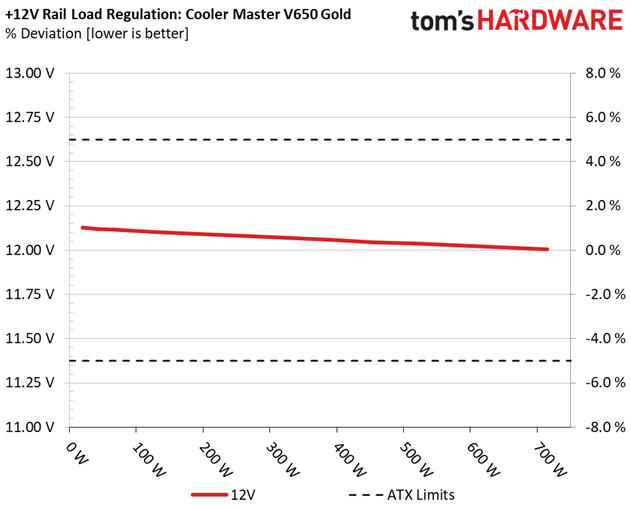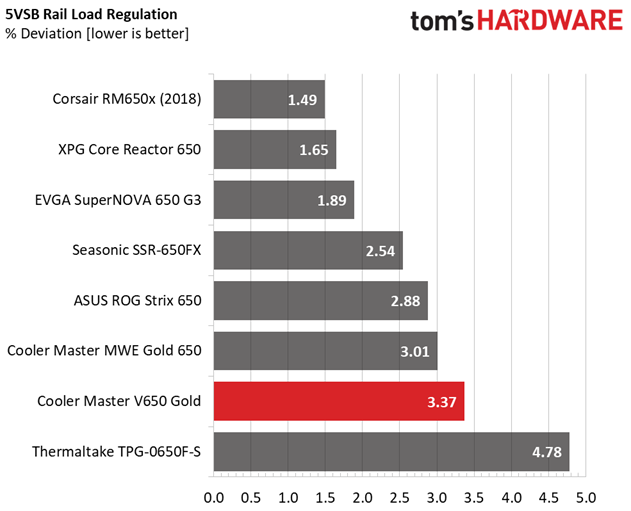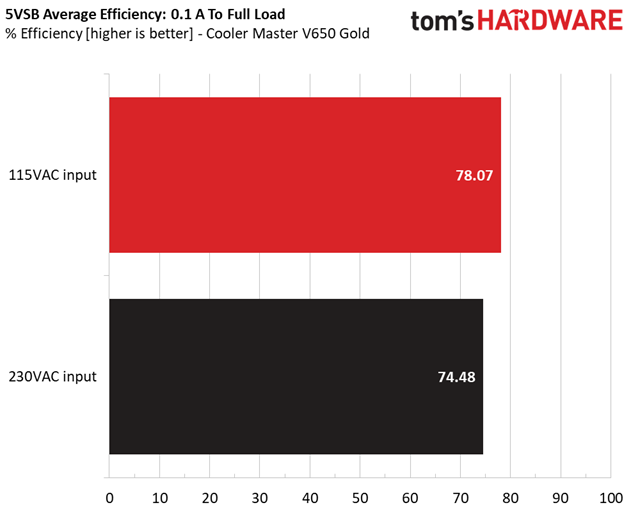Why you can trust Tom's Hardware
To learn more about our PSU tests and methodology, please check out How We Test Power Supply Units.
Primary Rails And 5VSB Load Regulation
The following charts show the main rails' voltage values recorded between a range of 40W up to the PSU's maximum specified load, along with the deviation (in percent). Tight regulation is an important consideration every time we review a power supply because it facilitates constant voltage levels despite varying loads. Tight load regulation also, among other factors, improves the system’s stability, especially under overclocked conditions and, at the same time, it applies less stress to the DC-DC converters that many system components utilize.

Results 1-8: Load Regulation







The load regulation is tight on all rails, but the competition (especially the Seasonic Focus Plus Gold) achieves notably better performance in this section.
Hold-Up Time
Put simply; hold-up time is the amount of time that the system can continue to run without shutting down or rebooting during a power interruption.

Results 9-12: Hold-Up Time






The hold-up time is longer than 20ms and the power-ok signal is accurate.
Inrush Current
Inrush current, or switch-on surge, refers to the maximum, instantaneous input current drawn by an electrical device when it is first turned on. A large enough inrush current can cause circuit breakers and fuses to trip. It can also damage switches, relays, and bridge rectifiers. As a result, the lower the inrush current of a PSU right as it is turned on, the better.

Results 13-14: Inrush Current

The inrush current is low with 115V, and at a normal level with 230V.
Get Tom's Hardware's best news and in-depth reviews, straight to your inbox.
10-110% Load Tests
These tests reveal the V650's load regulation and efficiency levels under high ambient temperatures. They also show how the fan speed profile behaves under increased operating temperatures.
| Test # | 12V | 5V | 3.3V | 5VSB | DC/AC (Watts) | Efficiency | Fan Speed (RPM) | PSU Noise (dB[A]) | Temps (In/Out) | PF/AC Volts |
| 1 | 4.317A | 1.961A | 1.971A | 0.997A | 74.461 | 84.964% | 0 | <6.0 | 42.86°C | 0.966 |
| 12.246V | 5.096V | 3.350V | 5.014V | 87.638 | 39.09°C | 115.12V | ||||
| 2 | 9.688A | 2.928A | 2.937A | 1.201A | 149.351 | 89.427% | 0 | <6.0 | 43.86°C | 0.991 |
| 12.227V | 5.122V | 3.370V | 4.997V | 167.009 | 39.81°C | 115.12V | ||||
| 3 | 15.470A | 3.421A | 3.421A | 1.406A | 224.860 | 90.524% | 0 | <6.0 | 45.18°C | 0.992 |
| 12.208V | 5.116V | 3.361V | 4.981V | 248.398 | 40.77°C | 115.11V | ||||
| 4 | 21.101A | 3.922A | 3.940A | 1.612A | 299.679 | 90.129% | 1583 | 40.9 | 41.87°C | 0.994 |
| 12.249V | 5.100V | 3.352V | 4.965V | 332.500 | 47.41°C | 115.11V | ||||
| 5 | 26.358A | 4.920A | 4.936A | 1.819A | 374.576 | 90.216% | 1616 | 41.5 | 42.40°C | 0.996 |
| 12.295V | 5.082V | 3.342V | 4.950V | 415.200 | 48.59°C | 115.11V | ||||
| 6 | 31.734A | 5.915A | 5.896A | 2.028A | 449.498 | 89.990% | 1677 | 42.1 | 42.73°C | 0.996 |
| 12.280V | 5.073V | 3.357V | 4.933V | 499.500 | 49.79°C | 115.11V | ||||
| 7 | 37.165A | 6.866A | 6.902A | 2.239A | 524.826 | 89.541% | 1754 | 43.1 | 43.00°C | 0.997 |
| 12.262V | 5.098V | 3.347V | 4.915V | 586.128 | 51.28°C | 115.11V | ||||
| 8 | 42.610A | 7.862A | 7.913A | 2.450A | 600.126 | 88.989% | 1805 | 43.9 | 43.63°C | 0.997 |
| 12.244V | 5.089V | 3.336V | 4.899V | 674.382 | 52.61°C | 115.11V | ||||
| 9 | 48.435A | 8.363A | 8.357A | 2.452A | 674.666 | 88.390% | 1858 | 44.6 | 44.24°C | 0.997 |
| 12.226V | 5.082V | 3.350V | 4.895V | 763.286 | 54.06°C | 115.11V | ||||
| 10 | 54.083A | 8.870A | 8.885A | 3.094A | 749.902 | 87.621% | 1902 | 45.3 | 45.99°C | 0.997 |
| 12.207V | 5.074V | 3.343V | 4.849V | 855.847 | 56.32°C | 115.11V | ||||
| 11 | 60.340A | 8.883A | 8.907A | 3.097A | 825.135 | 86.844% | 1929 | 45.7 | 46.67°C | 0.997 |
| 12.188V | 5.067V | 3.334V | 4.845V | 950.136 | 58.48°C | 115.11V | ||||
| CL1 | 0.143A | 16.004A | 16.000A | 0.000A | 138.568 | 82.764% | 1694 | 42.3 | 42.04°C | 0.992 |
| 12.219V | 5.142V | 3.408V | 5.069V | 167.425 | 48.66°C | 115.13V | ||||
| CL2 | 62.013A | 1.002A | 1.000A | 1.000A | 770.290 | 88.162% | 1869 | 44.8 | 45.81°C | 0.997 |
| 12.207V | 5.019V | 3.280V | 4.987V | 873.717 | 56.63°C | 115.11V |
The passive operation lasts until the 30% load test. Afterward and up to test #6, the fan spins at low speeds, keeping the noise output low. The PSU doesn't have a problem operating under high temperatures, while the PF readings are at satisfactory levels.
20-80W Load Tests
In the following tests, we measure the V650's efficiency at loads significantly lower than 10% of its maximum capacity (the lowest load the 80 PLUS standard measures). This is important for representing when a PC is idle with power-saving features turned on.
| Test # | 12V | 5V | 3.3V | 5VSB | DC/AC (Watts) | Efficiency | Fan Speed (RPM) | PSU Noise (dB[A]) | PF/AC Volts |
| 1 | 1.174A | 0.490A | 0.476A | 0.198A | 19.493 | 68.155% | 0 | <6.0 | 0.828 |
| 12.261V | 5.098V | 3.359V | 5.065V | 28.601 | 115.11V | ||||
| 2 | 2.418A | 0.980A | 0.983A | 0.396A | 39.927 | 79.120% | 0 | <6.0 | 0.921 |
| 12.256V | 5.096V | 3.355V | 5.052V | 50.464 | 115.11V | ||||
| 3 | 3.592A | 1.472A | 1.459A | 0.595A | 59.391 | 83.446% | 0 | <6.0 | 0.955 |
| 12.250V | 5.095V | 3.352V | 5.039V | 71.173 | 115.12V | ||||
| 4 | 4.838A | 1.963A | 1.968A | 0.796A | 79.832 | 85.849% | 0 | <6.0 | 0.971 |
| 12.245V | 5.094V | 3.349V | 5.026V | 92.991 | 115.12V |
There is no need for the fan to activate in such low loads, even at >35 degrees Celsius ambient temperatures. Moreover, the efficiency levels are pretty high.
2% or 10W Load Test
Intel plans on raising the ante at efficiency levels under ultra-light loads. So from July 2020, the ATX spec will require 70% and higher efficiency with 115V input. The applied load is only 10W for PSUs with 500W and lower capacities, while for stronger units we dial 2% of their max-rated-capacity.
| Test # | 12V | 5V | 3.3V | 5VSB | DC/AC (Watts) | Efficiency | Fan Speed (RPM) | PSU Noise (dB[A]) | PF/AC Volts |
| 1 | 1.044A | 0.263A | 0.264A | 0.051A | 15.289 | 63.901% | 0 | <6.0 | 0.792 |
| 12.268V | 5.078V | 3.359V | 5.075V | 23.926 | 115.11V |
With a 2% load of the PSU's max-rated-output, it is pretty high, but it doesn't exceed 70%.
Efficiency
Next, we plotted a chart showing the V650’s efficiency at low loads, and loads from 10 to 110% of its maximum-rated capacity. The higher a PSU’s efficiency, the less energy goes wasted, leading to a reduced carbon footprint and lower electricity bills.

Results 15-18: Efficiency




The efficiency levels are high in all load regions.
5VSB Efficiency
| Test # | 5VSB | DC/AC (Watts) | Efficiency | PF/AC Volts |
| 1 | 0.100A | 0.508 | 71.148% | 0.097 |
| 5.076V | 0.714 | 115.08V | ||
| 2 | 0.250A | 1.266 | 77.479% | 0.185 |
| 5.066V | 1.634 | 115.08V | ||
| 3 | 0.550A | 2.777 | 79.662% | 0.269 |
| 5.049V | 3.486 | 115.08V | ||
| 4 | 1.000A | 5.023 | 79.680% | 0.317 |
| 5.023V | 6.304 | 115.08V | ||
| 5 | 1.500A | 7.490 | 79.647% | 0.342 |
| 4.994V | 9.404 | 115.08V | ||
| 6 | 2.999A | 14.697 | 78.699% | 0.378 |
| 4.900V | 18.675 | 115.08V |

Results 19-20: 5VSB Efficiency

The 5VSB rail is highly efficient.
Power Consumption In Idle And Standby
| Mode | 12V | 5V | 3.3V | 5VSB | Watts | PF/AC Volts |
| 12.291V | 5.074V | 3.361V | 5.080V | 7.119 | 0.456 | |
| Idle | 115.1V | |||||
| 0.079 | 0.011 | |||||
| Standby | 115.1V |

Results 21-22: Vampire Power

With 115V input, the vampire power is low, but this is not the case with 230V.
Fan RPM, Delta Temperature, And Output Noise
All results are obtained between an ambient temperature of 37 to 47 degrees Celsius (98.6 to 116.6 degrees Fahrenheit).
Tha fan speed profile is not aggressive, even under high operating temperatures.
The following results were obtained at 30 to 32 degrees Celsius (86 to 89.6 degrees Fahrenheit) ambient temperature.
The passive operation, once selected, lasts for up to 190W loads, either at +12V alone or on all significant rails, combined. Afterward, with loads up to 450W, the PSU remains quiet since the fan's noise is below 25 dB(A). In the worst-case scenario, higher than 610W loads, the output noise is within the 35-40 dB(A) range.
MORE: Best Power Supplies
MORE: How We Test Power Supplies
MORE: All Power Supply Content
Current page: Load Regulation, Hold-Up Time, Inrush Current, Efficiency and Noise
Prev Page Specifications and Part Analysis Next Page Protection Features, DC Power Sequencing, Cross-Load Tests and Infrared Images
Aris Mpitziopoulos is a contributing editor at Tom's Hardware, covering PSUs.






